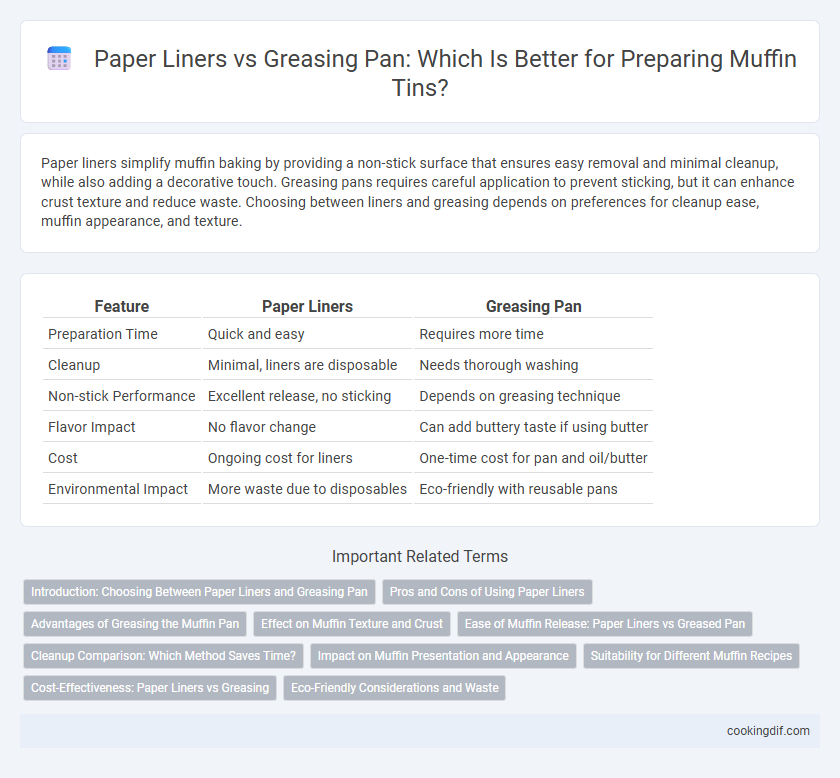Paper liners simplify muffin baking by providing a non-stick surface that ensures easy removal and minimal cleanup, while also adding a decorative touch. Greasing pans requires careful application to prevent sticking, but it can enhance crust texture and reduce waste. Choosing between liners and greasing depends on preferences for cleanup ease, muffin appearance, and texture.
Table of Comparison
| Feature | Paper Liners | Greasing Pan |
|---|---|---|
| Preparation Time | Quick and easy | Requires more time |
| Cleanup | Minimal, liners are disposable | Needs thorough washing |
| Non-stick Performance | Excellent release, no sticking | Depends on greasing technique |
| Flavor Impact | No flavor change | Can add buttery taste if using butter |
| Cost | Ongoing cost for liners | One-time cost for pan and oil/butter |
| Environmental Impact | More waste due to disposables | Eco-friendly with reusable pans |
Introduction: Choosing Between Paper Liners and Greasing Pan
Paper liners offer a convenient, mess-free option for muffin preparation, ensuring easy release and uniform baking. Greasing the pan provides a customizable, cost-effective method that enhances crust crispness and reduces waste. Selecting between these methods depends on factors like baking preferences, cleanup time, and recipe requirements.
Pros and Cons of Using Paper Liners
Paper liners for muffin tins offer a convenient, mess-free baking experience by preventing muffins from sticking, which simplifies cleanup and maintains the shape of the baked goods. However, paper liners can sometimes lead to uneven baking due to restricted heat circulation and may not provide the same crisp edges that greasing a pan achieves. While they enhance presentation and reduce the need for added fats, paper liners generate waste and may not be ideal for high-moisture or very sticky batter recipes.
Advantages of Greasing the Muffin Pan
Greasing the muffin pan ensures even browning and crispier edges by promoting direct contact between the batter and the metal surface. It eliminates the need for additional paper liners, reducing waste and simplifying cleanup. Greased pans also allow muffins to develop a golden crust, enhancing both texture and flavor.
Effect on Muffin Texture and Crust
Using paper liners in muffin tins retains moisture, resulting in a softer texture and preventing the crust from becoming overly crisp or dry. Greasing the pan, on the other hand, promotes direct contact between batter and metal, encouraging a firmer crust and slightly denser muffin edges. This difference significantly affects the final mouthfeel, with paper liners favoring tender, moist interiors, while greased pans enhance crust development.
Ease of Muffin Release: Paper Liners vs Greased Pan
Using paper liners significantly enhances the ease of muffin release by providing a non-stick barrier that prevents batter from clinging to the tin, ensuring intact and clean muffins. Greasing the pan relies on the quality and amount of grease applied, which can sometimes cause uneven baking or sticking if not done properly. Paper liners also simplify cleanup and maintain muffin moisture better compared to greasing pans, which may absorb oils and affect texture.
Cleanup Comparison: Which Method Saves Time?
Paper liners significantly reduce cleanup time when preparing muffin tins by preventing batter from sticking to the pan, eliminating the need for scrubbing or soaking. Greasing the pan requires more effort after baking, as residual grease and baked-on batter often necessitate thorough washing and scrubbing. Using paper liners offers a quick, efficient cleanup solution, ideal for saving time in busy baking routines.
Impact on Muffin Presentation and Appearance
Using paper liners in muffin tins creates a clean, uniform look that enhances muffin presentation by preventing sticking and preserving edges, resulting in visually appealing, well-defined shapes. Greasing the pan can cause muffins to have uneven surfaces or browned edges due to direct contact, which may compromise the overall appearance. Paper liners also offer convenient removal and hygienic handling, contributing to a polished and professional muffin display.
Suitability for Different Muffin Recipes
Paper liners provide a non-stick surface ideal for delicate or moist muffin recipes, ensuring easy removal and preserving the muffin's shape. Greasing pans suits recipes with higher fat content or those yielding crustier edges, as it promotes even browning and a crispy exterior. Choosing between paper liners and greasing depends on the muffin type and desired texture, optimizing baking results for each recipe.
Cost-Effectiveness: Paper Liners vs Greasing
Paper liners offer a cost-effective solution by reducing cleanup time and preventing batter from sticking, which minimizes waste and extends the life of baking tins. Greasing pans requires repeated purchase of oils or butter, which can add up over time and increase overall baking costs. Although greasing is cheaper initially, paper liners provide long-term savings through improved hygiene and consistent baking results.
Eco-Friendly Considerations and Waste
Paper liners reduce direct contact between muffins and baking tins, minimizing food waste and simplifying cleanup. Greasing pans typically involve oils or sprays that can introduce chemicals and increase waste through excess product use and non-recyclable packaging. Choosing biodegradable paper liners supports eco-friendly baking by reducing single-use plastic and easing waste disposal.
Paper Liners vs Greasing Pan for preparing tins Infographic

 cookingdif.com
cookingdif.com